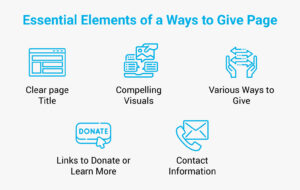
3 Ways Your Website Can Support Your Non-Cash Giving Efforts
3 Ways Your Website Can Support Your Non-Cash Giving Efforts

As a nonprofit fundraiser, you understand the importance of diversifying your revenue streams, and you’ve likely heard about (if not tried) several ways to do so. From corporate matching gifts to social media fundraising, nonprofits employ all sorts of strategies to appeal to different giving preferences and attract new donors.
Non-cash giving is one commonly overlooked or underdeveloped aspect of many nonprofit fundraising strategies. While there are a variety of non-cash assets that donors have and may be willing to contribute to your nonprofit, many are simply unaware of the opportunity.
In this guide, we’ll explore three ways your website can help you spread the word and boost your non-cash giving efforts:
- Educate your supporters.
- Provide social proof.
- Simplify the donation process.
Your website should contain everything visitors need to know to support your cause, like your nonprofit’s story, event calendar, and donation form. By featuring non-cash giving on your website, you’ll put the opportunity at the front of donors’ minds and start securing new streams of reliable revenue.
What is non-cash giving?
Before you start making specific website improvements to help secure non-cash gifts for your nonprofit, it’s important to get your entire team on the same page about non-cash giving and its benefits. Put simply, non-cash giving refers to the act of donating assets that are not cash to support a charitable cause.
More specifically, there are several common types of non-cash giving, including:
- Donor-advised funds (DAFs). Many wealthy donors set up DAF accounts with sponsoring organizations, like community foundations, into which they’ll make tax-deductible contributions. When they would like to distribute these funds to a specific nonprofit, they’ll recommend a grant and designate the amount to be given.
- Stocks. Donors can contribute appreciated stocks, bonds, and other securities to nonprofits. Doing so allows them to access tax benefits, such as avoiding capital gains taxes and claiming a deduction on the security’s fair market value.
- Cryptocurrency. By accepting cryptocurrency donations, your nonprofit can appeal to younger, more technologically inclined supporters. Cryptocurrency gifts, similar to gifts of securities, can bring added tax benefits that make them more appealing to prospective donors.
- Planned gifts. These gifts are usually deferred until after a donor’s passing. They typically involve the donor leaving assets such as real estate, retirement accounts, and life insurance policies to your nonprofit as part of their legacy.
The benefits of accepting these non-cash assets are clear—more flexible, convenient giving options that appeal to a wider variety of donors, meaning increased opportunities for your nonprofit to secure the funds it needs to grow. Your website will be a key marketing tool that will help you to tap into these benefits.
1. Educate your supporters.
Many current and prospective donors navigate to your nonprofit’s website to learn more about your organization, including your mission, how you’re making a difference in the lives of those you serve, and how they can contribute to your impact.
Use your website to educate your supporters about non-cash giving opportunities, starting with your Ways to Give page. This page is a simple yet crucial component of your website that should include elements such as a clear page title, compelling visuals, various ways to give, call-to-action (CTA) links, and information for contacting your nonprofit.

Add your non-cash giving options to your Ways to Give page and create additional resources that inform prospective donors about each option’s process and benefits, from how to donate stock to how to get started with planned gifts. Many nonprofits choose to build standalone microsites, often called planned giving websites, to house all their educational materials on different forms of giving so supporters have everything they need to decide how they’d like to contribute.
2. Provide social proof.
For donors who are unfamiliar with non-cash giving, highlighting others who have chosen and even prefer these methods of giving can go a long way toward inspiring them to try it out.
Include supporter testimonials in your educational resources that emphasize the ease and impact of non-cash giving. Additionally, consider launching a legacy giving society to cultivate a sense of community among your legacy donors.
Before you begin featuring their quotes and stories on your nonprofit’s website, however, Double the Donation’s donor recognition guide recommends asking your donors for permission first. While public recognition is an excellent way to show your nonprofit’s appreciation and infuse your content with social proof, some people may prefer to be thanked more privately.
Use multimedia to enhance your non-cash giving content, such as:
- Photo galleries of real non-cash donors
- “Why I Give” videos
- Podcast interviews
Like the rest of your website, ensure that your stories and testimonials follow accessibility best practices. For example, include captions and transcripts for your “Why I Give” videos and check that all of your pages are mobile-responsive. Doing so allows all of your website visitors to access your non-cash giving content and will maximize its positive impact.
3. Simplify the donation process.
Once you’ve brought non-cash giving to your donors’ attention, make it as easy as possible for them to choose one of these giving methods. This means streamlining their experience on your giving page. Start by understanding the logistics related to each type of non-cash giving’s donation process.
For instance, to accept gifts of cryptocurrency, your nonprofit needs to invest in a tool that seamlessly accepts and processes them on your website. Then, you should prioritize transparency by sharing key details with donors, such as the name of the company processing your cryptocurrency donations and whether you’ll be liquidating them immediately upon receipt.
Furthermore, it’s crucial to determine how you’ll follow up with and acknowledge your non-cash donors. FreeWill’s planned giving program rundown emphasizes the importance of appreciating and stewarding your legacy donors since many planned gifts are revocable.
Additionally, stock donations and DAFs are often reported anonymously, making it difficult for your nonprofit to collect data, thank donors, and steward them into long-term supporters. To address this issue, consider including a form on your giving page that requests the non-cash donor’s contact information before they make a contribution.
Gauge the effectiveness of your non-cash giving web content by regularly surveying supporters about their awareness of these options or which particular types of non-cash giving they’re most interested in. Use this information to tailor your communications strategy and expand your efforts to other platforms, such as your social media pages and email newsletter, to reach as many potential non-cash donors as possible.

